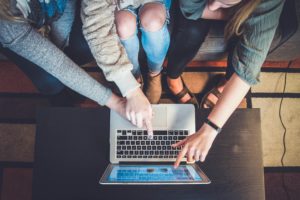Dikkers (2018) article “Social Interaction in K-12 Online Learning” brings up many interesting topics related to online and open learning spaces. One topic discussed is the foundational Transactional Distance Theory, which proposes the idea that distance is connected more with pedagogical decisions than the actual physical distance between the teacher and their students (Dikkers, 2018). With my own experience of taking online courses recently, I believe this to be true. That being said, what works for my learning style may not work for others. Building a meaningful connection with students in the online environment will vary from student to student. This is true in both open and online learning.
In order for teachers to effectively build safe relationships in both open and online learning spaces, pedagogical decisions are crucial. Dikkers’ (2018) article explains that when focusing on engagement with content and peers it does not lose social interaction and connections in online spaces. We have learned throughout the Education Program how important it is to build connections and bring a sense of community within students to make them feel comfortable with their learning environment. This is confirmed in Dikkers’ research as well and she also explains that by building these connections, students are able to focus better on “their learning [rather] than the online modality within which they are learning” (Dikkers, 2018, p. 512). I believe that building meaningful connections with students leads to building safe relationships. Finding a way to do this online may be more challenging than face to face, however, we have the technology tools available to help facilitate this. Zoom calls with their teachers and their class regularly, opportunities to give and receive feedback from peers and teachers, creating assignments that require collaboration or interacting with peers are all examples of ways to build safe relationships and motivate students.

Photo by John Schnobrich – Unsplash
With so many different technology tools available, it is important to consider the needs of all students and try and create a learning environment that encourages meaningful learning and connections. This week’s topic has also highlighted the importance of privacy concerns. Regan and Jesse (2019) discuss how many programs used at the K-12 level raise ethical concerns in regards to privacy. I myself find the thought of using technology programs in my future classroom somewhat overwhelming, as I want to ensure that student safety and privacy is top priority.

Photo byJoshua Hoehne on Unsplash
Overall, I will continue to ensure that FIPPA guidelines are being followed and have an open mindset towards online education. Although I have had my doubts about the ability to develop strong social interaction and connections through online learning tools, the articles in our readings make it clear that it is still possible to achieve these goals in the online and open learning environment. Given the current uncertainty in the world, and with the future of full time in classroom learning somewhat in flux for at least the near future, ensuring that we as educators use all methods possible to maximize social interaction and connections while in the online educational environment will be crucial.
References:
Garrett Dickers, A. (2018) Social Interaction in K-12 Online Learning. In R. Ferdig & K. Kennedy (Eds.), Handbook of research on K-12 online and blended learning (pp. 509-522 ). Pittsburgh, PA: Carnegie Mellon University ETC Press.
Regan, P., & Jesse, J. (2019). Ethical challenges of edtech, big data and personalized learning: Twenty-first century student sorting and tracking. Ethics and Information Technology, 21(3), 167-179. DOI: 10.1007/s10676-018-9492-2
Leave a Reply
You must be logged in to post a comment.